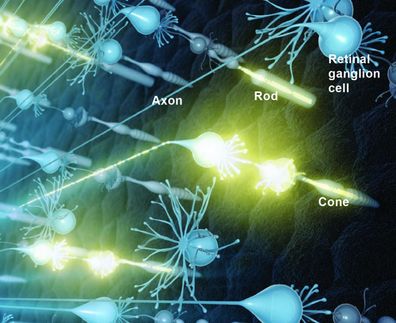New genes for short-sightedness identified
An international team of scientists led by King's College London has discovered 24 new genes that cause refractive errors and myopia (short-sightedness).
Myopia is a major cause of blindness and visual impairment worldwide, and currently there is no cure. These findings reveal genetic causes of the trait, which could lead to finding better treatments or ways of preventing the condition in the future.
Thirty per cent of Western populations and up to 80 per cent of Asian people suffer from myopia. During visual development in childhood and adolescence the eye grows in length, but in myopes it grows too long, and light entering the eye is then focused in front of the retina rather than on it. This results in a blurred image. This refractive error can be corrected with glasses, contact lenses or surgery. However, the eye remains longer, the retina is thinner, and this may lead to retinal detachment, glaucoma or macular degeneration, especially with higher degrees of myopia. Myopia is highly heritable, although up to now, little was known about the genetic background.
To find the genes responsible, researchers from Europe, Asia, Australia and the United States collaborated as the Consortium for Refraction and Myopia (CREAM). They analysed genetic and refractive error data of over 45,000 people from 32 different studies, and found 24 new genes for this trait, and confirmed two previously reported genes. Interestingly, the genes did not show significant differences between the European and Asian groups, despite the higher prevelance among Asian people. The new genes include those which function in brain and eye tissue signalling, the structure of the eye, and eye development. The genes lead to a high risk of myopia and carriers of the high-risk genes had a tenfold increased risk.
It was already known that environmental factors, such as reading, lack of outdoor exposure, and a higher level of education can increase the risk of myopia. The condition is more common in people living in urban areas. An unfavourable combination of genetic predisposition and environmental factors appears to be particularly risky for development of myopia. How these environmental factors affect the newly identified genes and cause myopia remains intriguing, and will be further investigated by the consortium.
Professor Chris Hammond from the Department of Twin Research and Genetic Epidemiology at King's College London, and lead author of the paper, said: 'We already knew that myopia – or short-sightedness – tends to run in families, but until now we knew little about the genetic causes. This study reveals for the first time a group of new genes that are associated with myopia and that carriers of some of these genes have a 10-fold increased risk of developing the condition.
'Currently myopia is corrected with glasses or contact lenses, but now we understand more about the genetic triggers for the condition we can begin to explore other ways to correct it or prevent progression. It is an extremely exciting step forward which could potentially lead to better treatments or prevention in the future for millions around the world.'
Currently, possibilities to reduce progression of myopia are very limited. While one drug, called atropine, may reduce progression, it dilates the pupil and causes problems with light sensitivity and difficulty with reading. New options are necessary. Chances are good that the insights gained from this study will provide openings for development of new strategies.























































